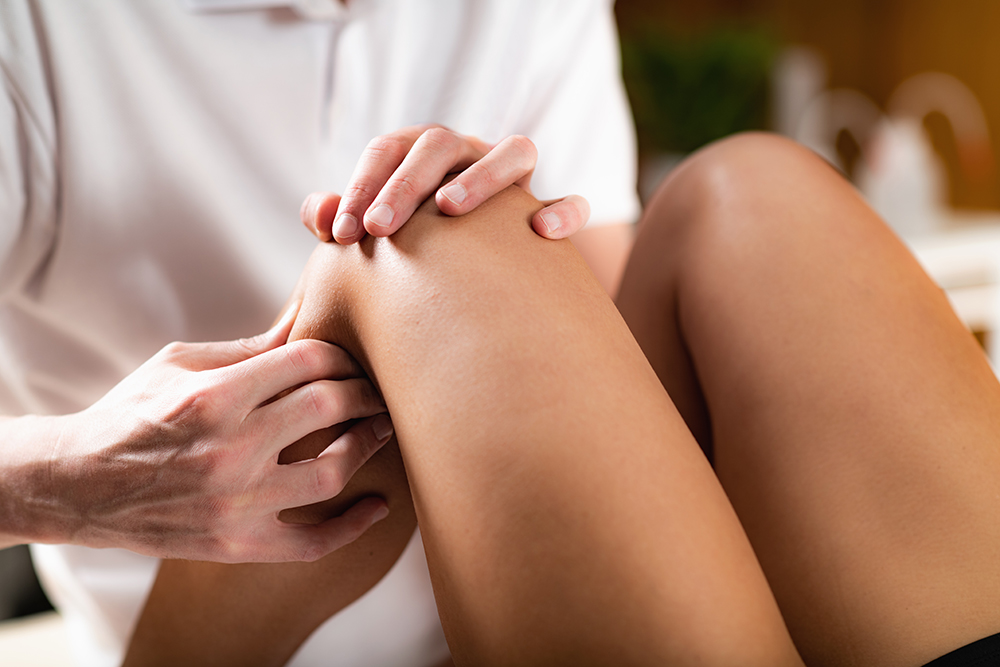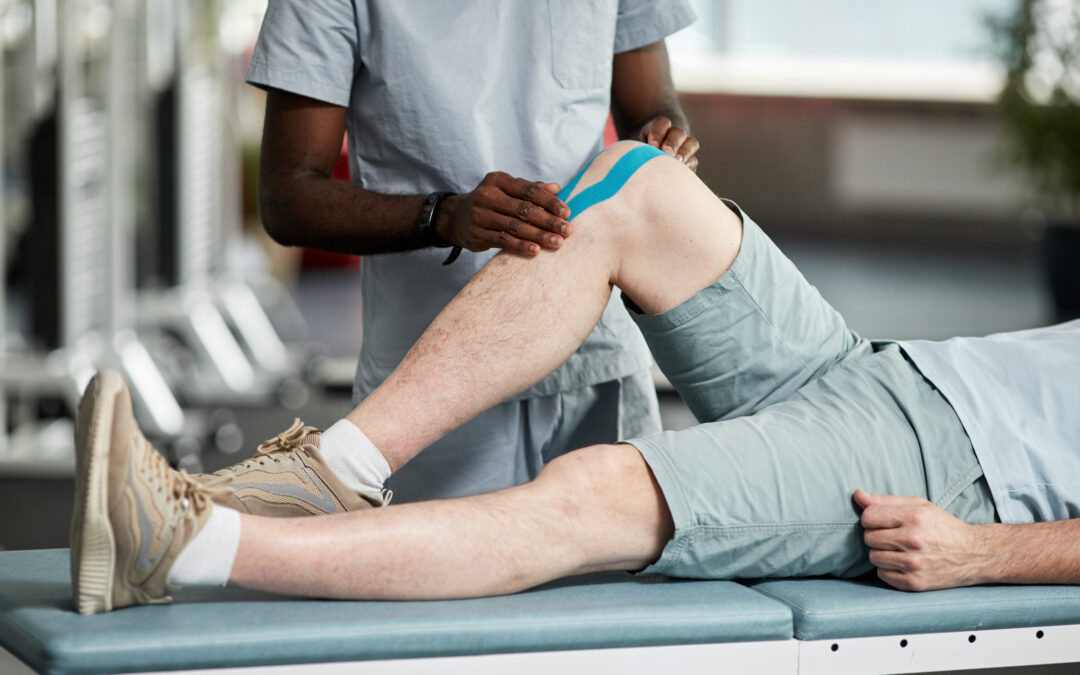Contents
When you have an issue with your knee, it can be tempting to just stay off your feet as much as possible until you feel better. However, if you’re experiencing persistent or worsening knee pain or stiffness, it can be helpful to book an appointment with a physical therapist. They can address and help alleviate symptoms of many knee conditions that may impact your quality of life. One of those conditions includes knee bursitis.
Knee bursitis is a condition that can develop when the bursae in the knee become overused by repetitive movements, or due to trauma. Bursae are fluid-filled sacs that work as cushions between bones and the surrounding soft tissue. If they become inflamed, it can lead to knee pain, swelling and tenderness. The symptoms can impact your overall quality of life if left untreated.
One of the first courses of action for treating persistent knee bursitis symptoms should be physical therapy. A physical therapist can help knee bursitis by reducing symptoms and improving the overall quality of the knee. There are a variety of treatments that may be included in your sessions. Treatment may involve exercises, manual therapy and other modalities.
Read on to learn the benefits of treating knee bursitis with physical therapy. We’ll also discuss specific exercises that a physical therapist may guide you through to help your symptoms.
6 benefits of using physical therapy for knee bursitis
We’ve confirmed that physical therapy can be effective for treating knee bursitis. Now we’ll dive deeper into why it’s a course of action worth pursuing. By understanding the benefits that you can gain from seeking the help of a physical therapist, you can see why physical therapy is often recommended for patients with knee bursitis by their health care providers.
Here are six benefits of receiving physical therapy treatment for knee bursitis:
- Reduced pain — When you seek treatment for a condition like knee bursitis, reducing the pain and discomfort is often the main priority. Your physical therapist can help decrease the symptoms that are interfering with your day-to-day activities. They may use treatments such as exercises and manual therapy, like joint mobilization. They may also use modalities to decrease your pain. Pain management modalities include kinesiology taping and electrical stimulation.
- Increased strength and flexibility — When you improve the overall quality of your knee, it can alleviate your current knee bursitis symptoms while also reducing the risk of future issues. Strength and flexibility are important aspects of your knee’s physical health, helping to ensure that the joint and surrounding soft tissue can withstand the daily strain placed on your knee. Your physical therapist can guide you through stretches and strengthening exercises that can reduce pain while improving the knee joint’s support.
- Improved gait and balance — Your knee is meant to carry approximately one and a half times your body weight as you move throughout the day. When it’s impacted by a condition like knee bursitis, it can affect your balance as well as your gait, which is the position of your body as you move. Your physical therapist can help you improve your balance and correct your gait to reduce the strain on your knee. They can also decrease the risk of a fall.
- Restored mobility — When your knee joint has a reduced range of motion, it can be difficult to carry out many everyday movements. It may be harder to climb stairs, extend your legs or crouch down to pick up clutter. Your physical therapist can help you restore your joint’s mobility that may be affected by knee bursitis. They may use targeted exercises as well as manual therapy techniques, such as joint mobilization. By improving your knee’s mobility, you’re also helping to restore its overall function for daily tasks.
- Lifestyle change recommendations — Knee bursitis is often the result of continuous stress on the knee or injury. You may develop the condition if you’re constantly kneeling on hard surfaces for your job. Perhaps you’re playing a sport that increases the risk of knee trauma. Your physical therapist can help you determine lifestyle changes in your everyday life that can reduce the risk of recurring knee bursitis, such as using protective devices, like a brace, and taking breaks if you’re kneeling for extended periods.
- Home exercise plan — Exercises are a pillar of nearly all physical therapy treatment plans. It’s important to be guided through exercises by a physical therapist to ensure that you’re completing them in a safe and effective manner for your condition. Not only will they show you how to perform them during sessions, but also, your physical therapist can design a home exercise program for you to follow in between appointments to continue your progress.
Physical therapy exercises for knee bursitis
Exercises are required to achieve many of the benefits that you can gain from physical therapy treatment for knee bursitis. From restoring mobility to increasing strength, exercises play an essential role in physical therapy.
Here are a few physical therapy exercises that your physical therapist may guide you through to help your knee bursitis, and how they can help:
- Heel slides — This exercise involves lying on your back and sliding the heel of your foot up toward your buttocks. Heel slides can help knee bursitis by improving the joint’s range of motion, which can be restricted by the inflamed bursa. It works by stretching the surrounding tissue.
- Quad sets — By engaging your quad muscles through targeted exercises, you’re strengthening the muscles that provide support for your knee joint. Increased support provides stability for the knee while also reducing the pressure placed on the bursa. A quad set involves lying on your back and pressing your knee down onto a towel.
- Straight-leg raises — A straight-leg raise involves lying on your back with one leg extended and one leg bent. You tighten your thigh muscles to lift your extended leg in the air until it’s at an even height with your bent knee. Similar to a quad set, this exercise helps reduce knee bursitis symptoms by strengthening your quad muscles.
Lattimore PT can provide effective physical therapy treatment for knee bursitis
Life doesn’t stop when you’re in pain. That’s why it’s important to be proactive about persistent or worsening knee bursitis symptoms. Instead of trying to simply deal with the pain, you can reduce the ache and carry on with your everyday activities. That’s where we come in.
At Lattimore PT, we can help you manage your knee bursitis symptoms while also improving the overall quality of the joint and muscles for improved function and mobility. We’ll complete an evaluation of your symptoms, strength, flexibility, balance and range of motion during your first appointment with us. We can use that information, along with our expert insight, to determine the treatments that will help you get the best results possible, such as exercises and manual therapy.
When it comes to manual therapy for your knee bursitis, we make sure to provide you with the highest quality of care possible. Lattimore PT has 30 fully certified COMTs, which stands for Certification in Orthopedic Manual Physical Therapy. We’re the only place in town with a COMT in almost every clinic.
Contact our team today for more information or to schedule an initial appointment.



